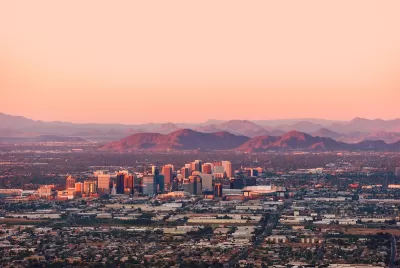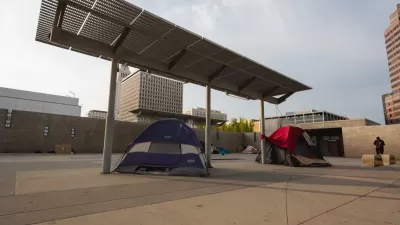The last decade saw a lethal combination of higher temperatures, rapid population growth, and rising eviction rates.

“Relentless heat led to 645 deaths last year in Maricopa County, the most ever documented in Arizona’s biggest metropolitan area,” reports Ariel Wittenberg in Politico. That amounts to a 1,000 percent increase in the last decade, growth attributed to longer, more intense heat waves coupled with rising eviction rates that put more Phoenix residents outdoors and at risk.
According to Wittenberg, “Almost half of the victims last year were homeless — 290 people. Twenty died at bus stops, others were in tents, and an unrecorded number of people were found on the pavement, prone as if on a baking stone.”
The city is using federal funding to operate cooling centers with longer hours, but these lifelines face an uncertain future when those funds run out. “With no stable federal funding, the location of cooling centers and bottled water distribution points changes each year, depending on whether fleeting resources will be provided by the city, county or state. Churches and local charities supplement government aid with their own donations of water and cool spaces,” Wittenberg explains.
While some city councilors don’t want to see resources used to assist unhoused people, Phoenix is one of the cities that is — by necessity — taking extreme heat seriously as a public health hazard, creating a new city office to spearhead heat mitigation strategies. At the state level, an Extreme Heat Preparedness Plan resulted in a new statewide cooling center coordinator and a chief heat officer.
FULL STORY: ‘Just brutal’: Why America’s hottest city is seeing a surge in deaths

Planetizen Federal Action Tracker
A weekly monitor of how Trump’s orders and actions are impacting planners and planning in America.

San Francisco's School District Spent $105M To Build Affordable Housing for Teachers — And That's Just the Beginning
SFUSD joins a growing list of school districts using their land holdings to address housing affordability challenges faced by their own employees.

The Tiny, Adorable $7,000 Car Turning Japan Onto EVs
The single seat Mibot charges from a regular plug as quickly as an iPad, and is about half the price of an average EV.

Trump Approves Futuristic Automated Texas-Mexico Cargo Corridor
The project could remove tens of thousands of commercial trucks from roadways.

Austin's First Single Stair Apartment Building is Officially Underway
Eliminating the requirement for two staircases in multi-story residential buildings lets developers use smaller lots and more flexible designs to create denser housing.

Atlanta Bus System Redesign Will Nearly Triple Access
MARTA's Next Gen Bus Network will retool over 100 bus routes, expand frequent service.
Urban Design for Planners 1: Software Tools
This six-course series explores essential urban design concepts using open source software and equips planners with the tools they need to participate fully in the urban design process.
Planning for Universal Design
Learn the tools for implementing Universal Design in planning regulations.
Smith Gee Studio
City of Charlotte
City of Camden Redevelopment Agency
City of Astoria
Transportation Research & Education Center (TREC) at Portland State University
US High Speed Rail Association
City of Camden Redevelopment Agency
Municipality of Princeton (NJ)





























